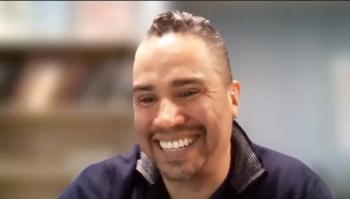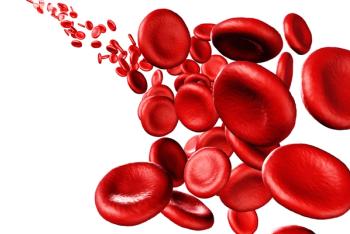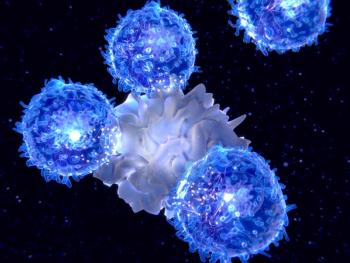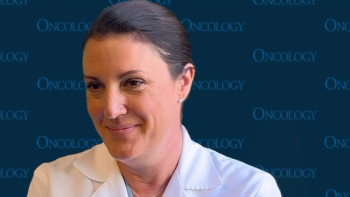
- ONCOLOGY Vol 38, Issue 10
- Volume 38
- Issue 10
- Pages: 384-386
Linvoseltamab Still Efficacious Despite CRL in Multiple Myeloma
“I don't think [the CRL] impacts how I look at the data that is publicly available and the approval chances long term for linvoseltamab and how we might use it in the future,” said Surbhi Sidana, MD.
A complete response letter (CRL) was recently issued by the FDA for the BCMA bispecific antibody, linvoseltamab, for use in patients with relapsed/refractory multiple myeloma.1 The decision followed an issue discovered during an inspection of third-party manufacturing facility involving the packing of the drug for storage and distribution. It has since been resolved and a re-inspection is planned in the coming months.
CancerNetwork® spoke with Surbhi Sidana, MD an associate professor and hematologist in the Department of Medicine, Division of Blood and Marrow Transplantation and Cellular Therapy at Stanford University School of Medicine. She shared her thoughts on the recent FDA decision and
Sidana began by assuring that the CRL was unrelated to the findings of the LINKER-MM1 trial, expressing the FDA rightfully made the decision to re-inspect the manufacturing facility in the coming months prior to arriving at a final decision. She reinforced the assurance by highlighting unprecedented efficacy results yielded from the trial, as well as manageable safety congruent with similar bispecific antibodies and immunotherapies.
Furthermore, Sidana shared promising developments in multiple myeloma that she believes will impact clinical practice. She concluded the interview by addressing the incidence of infections following treatment, recommending an “aggressive” supportive care approach and potential dose reductions for patients to reduce high-grade infection frequency.
Q: How does the CRL from the FDA regarding linvoseltamab in relapsed/refractory multiple myeloma impact the treatment landscape?
Sidana: Linvoseltamab received a CRL from the FDA in response to its biologic license application. For those who are not familiar with what the CRL is, let me break it down. When a company submits an application for a new drug approval, in this case, Regeneron submitted for linvoseltamab– which is a BCMA CD3 bispecific antibody in myeloma– the FDA, when it has certain things it wants to course correct for the application itself, will issue a CRL. In this case, they showed a CRL in response to an inspection at a manufacturing facility where linvoseltamab [is partially] manufactured or filled, and they found some deficiencies.
It was not related to data, as I understand it, for linvoseltamab in the clinical trial per se, but related to a third-party manufacturing facility. Now, in most cases, this is not unusual to receive a CRL. If the manufacturer and its affiliates can address the deficiency that is listed by the FDA, it then clears the path for FDA approval. This might be a delay for appropriate reasons that the FDA noted, but I do not think that this will lead to any long-term repercussions for linvoseltamab [regarding] FDA approval.
Q: Is the CRL a setback for this agent?
Sidana: In the big picture, CRLs are usually certain deficiencies that are noted by the FDA. In this case, it was at a manufacturing plant that was a third-party facility. Overall, the linvoseltamab program– yes, they have to address this. Yes, this might delay things for a certain period for FDA approval. In the big picture, I don’t think this impacts how I look at the data that is publicly available, the approval chances long-term for linvoseltamab, and how we might use it in the future. This is my read on the data that is publicly available.
Q: What benefit was observed with linvoseltamab in the LINKER-MM1 trial?
Sidana: LINKER-MM1 is a phase 1/2 trial of linvoseltamab, a BCMA CD3 bispecific antibody in patients with relapsed/refractory multiple myeloma. I will focus more so on the phase 2 portion that evaluated 2 doses of linvoseltamab: a 50 mg dose and a 200 mg dose; both were given intravenously [IV]. Over 100 patients were treated in both arms, and they wanted to evaluate the efficacy of these 2 doses. The step-up dosing was once a week IV with hospitalization for 24 hours after 2 step-up [doses]– week 1 and week 2. Starting week 3, patients received the full dose every week. Starting month 4 or week 16, it went to every other week. Now, there are some nuances in dosing, such that if [patients] were on the higher dose of 200 mg, starting week 24 approximately month 6 if [patients] were in a deep response, [very good partial response] or better with a 200 mg dose, [patients] could even go to every 4 weeks [to improve] patient convenience.
They did note that the responses were better in the 200-mg dose than in the 50-mg dose. To back up, let me describe the population a little bit, and ‘'ll focus more on the 200-mg dose, since that’s where the higher response rate was seen, even though responses were good in both arms, meeting the null hypothesis: about 50% in the 50 mg and 70% in the 200 mg [groups].
The 200-mg dose was a heavily pretreated cohort of [patients with] multiple myeloma with a median of 5 prior lines of therapy. Two-thirds of these patients were triple-class refractory, which means refractory to an immunomodulatory [IMID]drug, to a proteasome inhibitor [PI], and an anti-CD38 antibody. Historically, these patients do poorly. Twenty-eight percent of these patients were penta-refractory—that is refractory to 2 PIs, 2 IMIds, and an anti-CD38 antibody.
Historically, these patients have had extremely poor outcomes. The overall response rate with non-immunotherapy options has been about 30% in these patients with a median PFS of 3 to 4 months. In the 200-mg dose, we saw a response rate of approximately 71%, which is more than double what we would have seen historically with non-immunotherapy options.
Importantly, most of these responses were deep and durable responses. The CR rate and VGPR rates are very high, with an over 60% VGPR rate at a median follow-up of about 14 months, the median progression-free survival [PFS] has not yet been reached, and the estimated 12-month PFS [rate] is about 70%. This is quite remarkable when we look at historical data. Overall, this is a very positive trial with bispecific antibody targeting BCMA, in terms of efficacy, high response rates, which are durable, and a median PFS [which was] not yet reached.
Talking about safety in terms of [adverse] effects and toxicity, both in the short term and long term, the safety profile was also comparable to other BCMA bispecifics that are currently FDA-approved or in development. Now, cytokine release syndrome (CRS) is commonly seen with bispecific antibodies. It was seen in about 46% of patients, so less than half of the patients [had] mostly grade 1 and 2, with very few grade 3 and 4 cases seen. Now, grade 1 is just a fever, grade 2 is a fever and low blood pressure that responds to fluid. You can see that those are typically very manageable.
One difference compared with other agents is that, because this is given IV, vs other BCMA bispecific [which] are subcutaneous. The onset of CRS is fairly rapid here, within a few hours, 6 to 8 hours on average, compared with a couple of days with other subcutaneous agents, which has implications for hospitalizations, and that’s why there was a 24-hour hospitalization requirement in the protocol. We will wait and see when this agent gets approved, and what will come in the package insert in terms of hospitalization requirements.
The other toxicity that is seen with immunotherapy bispecific antibodies is neurotoxicity or ICANS, immune cell-associated neurotoxicity syndrome, and that was seen in about 7.7% of patients. Again, less than 10% which is common for this class of drugs. Now, infections are also very common with BCMA bispecific antibodies and grade 3 or 4. Infections here were seen in about 35% of patients, and a little around 5% were grade 5, so about 35 to 40% were grade 3 or higher infections. This is also keeping in line with other BCMA bispecific antibodies that are currently FDA-approved or in development, so the safety signal was very comparable in general.
Q: Do you believe linvoseltamab has a place in the relapsed/refractory multiple myeloma landscape as an approved agent?
Sidana: Yes, I do believe linvoseltamab has a place in the relapse/refractory multiple myeloma landscape as an approved agent. Now we should note there are 2 FDA approved bispecific antibodies that are already there, teclistamab-cqyv (Tecvayli), which was approved in late 2022, and elranatamab-bcmm (Elrexfio), which was approved in mid-2023. However, when we take examples from other cancers, there is a host of immunotherapy options which we might choose to use–– one over the other, depending on center preferences, toxicity profile, convenience, and sometimes cost and formulary issues.
Certainly, there is a need for bispecific antibodies in multiple myeloma, and there are certain differences in schedule and administration. Of course, the cost remains to be determined. Yet we do not know anything about the cost, which may give it a place in the multiple myeloma treatment armamentarium.
Q: The FDA stated in the CRL that a re-inspection will occur in the coming months. What do you believe are the next steps for this agent?
Sidana: As stated in the CRL, a re-inspection is expected to occur in the coming months. The next steps would be waiting for that to happen and waiting for the FDA response. As I understand from the publicly available data, that is the only deficiency that has been raised to date. We expect that, once that occurs, and is, if that's successful, we expect to see FDA approval for this agent.
Q: What other developments in multiple myeloma have the potential to impact clinical practice?
Sidana: We are living in very exciting times in multiple myeloma. Over the last 3 to 4 years, we have had FDA approvals for 2 CAR [T-cell therapies], idecabtagene autoleucel (ide-cel; Abecma) and ciltacabtagene autoleucel (cilta-cel; Carvykti), that target BCMA; 3 bispecific antibodies, 2 that target BCMA, teclistamaband elranatamab, and another that targets GPRC5D, talquetamab-tgvs (Talvey). Now we have other BCMA bispecifics, including linvoseltamab, that may get approved in the near future.
[There are] many other targets in development, both for bispecifics and CAR T, and also other drugs, like CELMoDs iberdomide and mezigdomide, [that] have shown promising data. We also had belantamab mafodotin-blmf (Blenrep), which was initially FDA-approved.
Another phase 3 study shows very promising data that was presented in the summer meetings in 2024, so this is a very exciting landscape—not only for the approval of new agents in late relapse, but also for earlier line approval of agents like CAR T. Over the summer, we had early-line approval of both cilta-cel, after 1 prior line of therapy for patients who were [lenalidomide (Revlimid)]-refractory, and ide-cel after 2 prior lines of therapy.2,3 Bispecifics are being investigated in earlier lines over the next couple of years. As those trial data come in, we would expect, hopefully to get those moved into earlier lines.
Q: Is there anything else that you would like to highlight regarding linvoseltamab as a treatment, the LINKER-MM1 trial or the FDA decision?
Sidana: [What] I want to highlight about linvoseltamab and other BCMA bispecific antibodies and immunotherapy, in general, is the importance of good supportive care. These are very effective agents in terms of efficacy, but the lesson that we learned from the early trials was that infection is a big signal. We have to be very aggressive, especially as these treatments move into the community where they might not have experience with clinical trials. We have to be very aggressive with infection prophylaxis, including using drugs for zoster prophylaxis [and] PJP [pneumocystis jiroveci pneumonia] prophylaxis, because cases of PJP pneumonia were seen. We have to be very aggressive with intravenous immunoglobulin, which is very effective in preventing grade 3 or higher infections in patients treated with BCMA bispecific antibodies. [We] have to be careful.
Also, in the real world, a lot of us are reducing the frequency of these agents. In the teclistamab trials, it was shown that, as you reduce the frequency the risk of infection does go down over time. [These are] very practical aspects that I want to highlight, with not just linvoseltamab, but all BCMA bispecific antibodies.
References
- Regeneron provides update on biologics license application for linvoseltamab. News release. Regeneron Pharmaceuticals, Inc. August 20, 2024. Accessed August 27, 2024.
https://tinyurl.com/2u2pvw82 - Carvykti is the first and only BCMA-targeted treatment approved by the US FDA for patients with relapsed or refractory multiple myeloma who have received at least one prior line of therapy. News release. Johnson & Johnson. April 5, 2024. Accessed August 30, 2024.
https://tinyurl.com/3rjpfkjw - US FDA approves Bristol Myers Squibb and 2seventy bio’s Abecma for triple-class exposed relapsed or refractory multiple myeloma after two prior lines of therapy. News release. Bristol Myers Squibb and 2seventy bio, Inc. April 4, 2024. Accessed August 30, 2024. https://tinyurl.com/pnb74fyc
Articles in this issue
about 1 year ago
The Evolving Landscape of Prostate Cancer Managementabout 1 year ago
Expert Commentary on the Product Profile of Lazertinib in NSCLCabout 1 year ago
Hereditary Renal Tumor Syndromes and the Use of mTOR Inhibitorsabout 1 year ago
Breast Cancer Breakthroughs: 2024 ESMO HighlightsNewsletter
Stay up to date on recent advances in the multidisciplinary approach to cancer.























































































